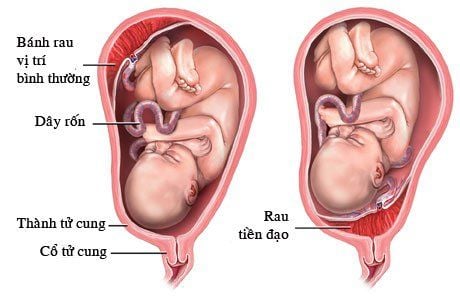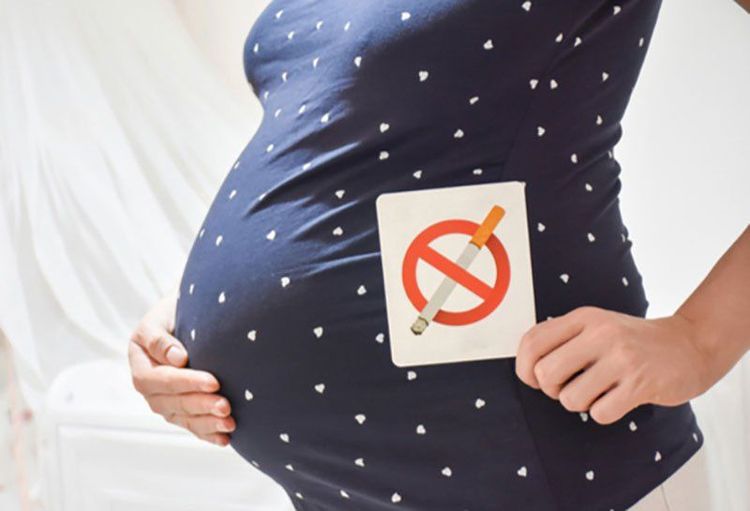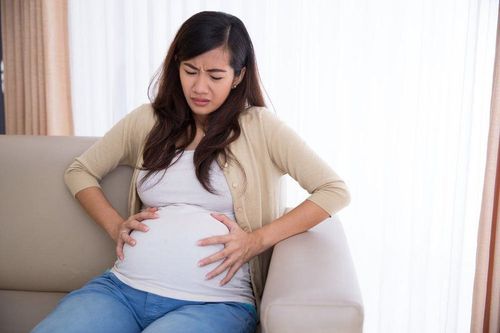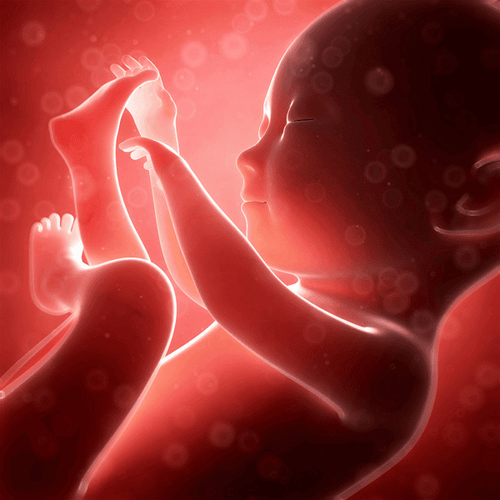This is an automatically translated article.
The article is professionally consulted by Dr., Doctor Ngo Thi Uyen - Obstetrician and Gynecologist - Department of Obstetrics and Gynecology - Vinmec Nha Trang International General HospitalThe role of the placenta in pregnancy is very important, it develops in the uterine cavity during pregnancy and provides oxygen and nutrients for the developing fetus and cleans waste in the fetal blood.
1. The position of the placenta in the uterus?
The placenta attaches to the wall of the uterus, usually above, to the side, in front of or behind the uterus, and the baby's umbilical cord grows from it. In rare cases, the placenta can attach to the lower part of the uterus (placenta previa).

Cấu tạo của nhau thai
2. What affects the health of the placenta?
There are many factors that affect the placenta during pregnancy, some can change, some do not. We have the following factors:
Maternal age: Some placental problems are more common in older women, especially after the age of 40. Premature rupture of membranes: During pregnancy, the mother's baby is surrounded by a fluid-filled membrane called the amniotic sac. If the sac leaks or ruptures before the mother goes into labor, the risk of some problems with the placenta is increased. High blood pressure: High blood pressure in the mother will affect the placenta. Twins or multiples: If a mother is carrying more than one baby, the risk of placental problems increases. Blood clotting disorders: Any condition that impairs the blood's ability to clot or increases its ability to clot increases the risk of certain placental problems. Previous uterine surgery: If the mother has had a surgical intervention in the uterus, such as a cesarean section or fibroid removal, there is an increased risk of problems related to the placenta. Previous Placental Problems: If there were placenta problems in a previous pregnancy, there is a high chance of having similar problems again. Drug abuse: Some placental problems are common in women who smoke or use illicit drugs such as cocaine during pregnancy. Abdominal trauma: Abdominal trauma such as a fall or other impact increases the risk of the placenta being separated from the uterus (placental abruption or placental abruption).
3. Possible diseases of the placenta during pregnancy?
During pregnancy, possible problems include placental abruption, placenta previa, and placenta previa. These problems can cause severe vaginal bleeding. The placenta after birth is also a matter of concern. Here's what you need to know about these issues:Placental abruption: The rate of placental abruption accounts for about 0.5% of pregnant women. If the placenta is shed from the uterine wall before birth, either partially or completely, it deprives the baby of oxygen and nutrients and causes severe bleeding. Placental abruption leads to an emergency that requires the delivery of the baby earlier than expected. Placenta previa: This condition occurs when the placenta partially or completely covers the cervix – the outlet of the uterus. Placenta previa usually appears in the early months of pregnancy and may improve as the uterus grows. Placenta previa can cause severe vaginal bleeding during pregnancy and labor. Managing this problem depends on the amount of blood loss, if the bleeding stops, what stage of pregnancy you are in, the position of the placenta, and the health of the mother and fetus. If placenta previa persists in the third trimester, your obstetrician will recommend a cesarean section. Prevalence of placenta previa accounts for about 0.5% of all pregnant women, the more times the cesarean section, the higher the risk of placenta previa. This accounts for 10%. Placenta Comb: This condition occurs when blood vessels and other parts of the placenta grow deep into the uterine wall. Normally, the placenta detaches itself from the uterine wall after birth, but with the placenta in place, part or all of the placenta remains firmly attached to the uterus, causing severe postpartum blood loss that can lead to death. Your obstetrician will recommend a cesarean section and total hysterectomy. In severe cases, the placenta invades the uterine muscle or grows through the uterine wall. The rate of placenta accreta accounts for about 0.35% of pregnant women, but this rate will increase in women who are old and have a history of cesarean section, especially multiple cesarean sections. Retained Placenta: If the placenta is not completely pushed out of the uterus within 30 minutes after birth, it is called a residual placenta. Missing placenta can occur because the placenta is trapped because the cervix is partially closed, or the placenta is still attached to the uterine wall – whether superficial (adhesive placenta) or deep (placental placenta). If left untreated, a retained placenta can cause severe infection or life-threatening blood loss.
4. What are the signs or symptoms of a placental problem?
Pregnant women should see a specialist as soon as they have the following symptoms:
Vaginal bleeding. Stomachache. Backache. Uterine contractions.
5. What can pregnant women do to reduce the risk of placental problems?

Không hút thuốc nhằm giảm nguy cơ mắc phải vấn đề của nhau thai.
Most problems related to the placenta cannot be prevented directly. However, you can take steps to have a healthy pregnancy.
Visit a specialist regularly throughout your pregnancy. See your doctor to manage any health problems such as high blood pressure. Do not smoke or take illegal drugs. Get professional advice before deciding to have an elective cesarean section If you've had a placenta problem in your previous pregnancy and are planning to have another baby, see your doctor for advice on options. reduce the risk of getting it again. Be sure to notify your doctor if you have had uterine surgery and present to be closely monitored throughout your pregnancy.
6. How is the placenta ejected?
If you give birth vaginally, the placenta will also be pushed out through the vagina – during the third stage of labor. Postpartum, mild uterine contractions continued. The doctor will prescribe Oxytocin (Pitocin) to reduce postpartum bleeding, and the doctor will also massage the lower abdomen to stimulate the uterus to contract and expel the placenta. In the case of a cesarean section, the doctor will remove the placenta from the uterus during the operation.
Your doctor will check to make sure the placenta is intact. Any remnants must be removed from the uterus to prevent bleeding and infection. If desired, the mother can request to see the placenta. In some cultures, families bury the placenta in a special place, such as the backyard.
If you have any questions regarding the placenta or related problems during pregnancy, consult a specialist. Your doctor will help you better understand the role the placenta plays in pregnancy.
Please dial HOTLINE for more information or register for an appointment HERE. Download MyVinmec app to make appointments faster and to manage your bookings easily.
Articles refer to the source: Mayoclinic













